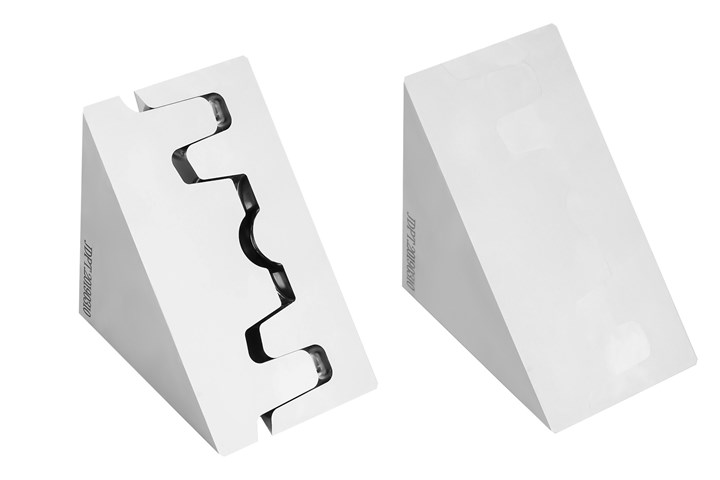
The precise fit of this part was possible with on-machine measurement and intelligent modification technology integrated into the control of a high-speed machining center. Photo Credit, all images: Jingdiao North America
Machining a micron-level precision mold on the first try is difficult to achieve. Machining the mold two or more times is often necessary to reach the required micron-level tolerance. Variables such as the machining environment, machine stability, cutting tool wear, and accuracy and operator experience impact micron-level machining results.
The opening image shows a 300- × 195-millimeter (M333, HRC50) part produced on a high-speed mill using a polycrystalline diamond (PCD) cutting tool continuously for 80 hours. The tool wear was less than 0.8μm, which achieved a mirror Sa surface finish within 10 nanometers.
The precise fit of this machining sample begs three questions:
- How were these parts machined?
- How can they fit so perfectly together with a disappearing parting line?
- How can this be done with no secondary operations?
On-machine measurement and intelligent modification technology integrated into the control of a high-speed machining center is one way to overcome these variables. These functions identify and eliminate any inherent deviations in key machining elements, which yields efficient, stable machining of micron-level precision molds.

On-machine measurement and intelligent modification produced this mirror Sa surface finish within 10 nanometers.
Here’s how it works and what to consider.
Key Features and Functions
A high-speed precision machining center with integrated on-machine measurement and intelligent modification technology has a set of measurement systems in the machine’s control. First, the measurement points are created in the CAM system. Then, after the program is created, the NC code, measurement points and the part’s solid model file are imported into the control. The operator machines the part and then selects the critical measurement points program. An accuracy heat map of the solid model file appears on the control, which visually indicates to the operator if the part is within tolerance.
On-machine measurement and intelligent modification technology turns traditional machining into digital control.
The digital processing capability of a high-speed machining center’s CNC system makes machining micron-level precision molds in one pass possible. For example, the proper digital processing capability will acquire data acquisition from various measuring instruments and temperature sensors to form a closed-loop, on-machine measurement and intelligent modification function, which efficiently and accurately carries out the measurement work on the CNC machine. It’s like having a CMM built into your high-speed mill.
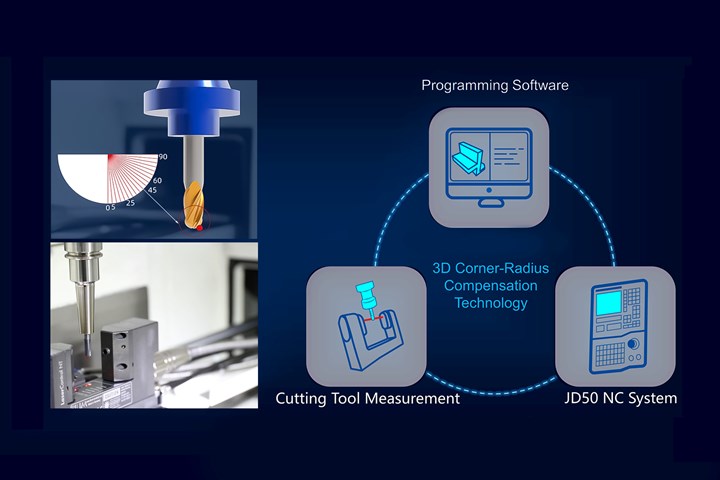
The on-machine measurement and intelligent modification control function permits contour measurement of the cutting tools.
Regarding part size measurement, on-machine measurement and intelligent modification technology uses a probe that performs a preliminary inspection of the machined workpiece. Like a CMM, the control creates an accuracy heat map and informs the operator if the part is within spec. The operator can also export the measurement results and heat map image with the machining data.
Then there is the cutting tool, for which there can be an inherent deviation between the actual cutter size and the theoretical cutter data during manufacturing. Even the most accurate cutting tools have a tolerance. With on-machine measurement and intelligent modification technology in conjunction with the CNC system, the operator can use the laser tool calibrator to measure the inherent deviation of the cutting tool’s radius and perform multipoint compensation according to the cutter’s contour. After each tool is 3D measured, its actual value is automatically stored in the control, yielding more accurate machining results.
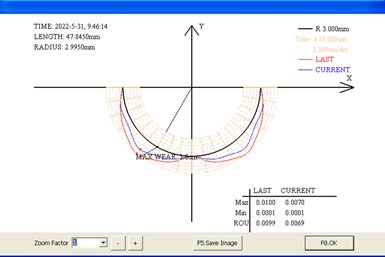
Contour deviation comparison of a cutting tool before and after machining.
The operator can also measure cutting tool wear with on-machine measurement and intelligent modification technology that uses a laser tool calibrator to measure the change in cutting tool size due to wear. If wear exceeds a specific range — especially in the finishing process — it is necessary to carry out corresponding correction work to ensure that the following cutting tool removes the proper amount of material. For example, the control gives directions to measure the cutting tool after a specified time and if the wear is more significant than expected, the control changes to a new cutting tool.
Tool wear can also lead to uneven surface finish, which causes the workpiece material to be inconsistent with the machining model. On-machine measurement and intelligent modification technology uses a probe to measure the allowance according to the set value. Then the detection map of the remaining surface stock is output in real time. This feature directly analyzes the detection data on the machine tool side.
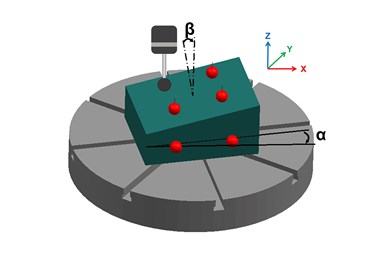 Integrated on-machine measurement and intelligent modification technology offers workpiece position compensation.
Integrated on-machine measurement and intelligent modification technology offers workpiece position compensation.Another challenge is manually aligning a workpiece with an imprecise indicator or inexperienced operator that consumes labor time and produces inaccurate results. High-precision machining centers that automatically align the workpiece in X, Y and Z planes are more accurate and reduce setup time. For example, modeling features that define the workpiece coordinate system for the machined material improves high-speed machining accuracy.
Machine tools are very sensitive to heat when performing precise machining. On-machine measurement and intelligent modification technology can use a probe and standard ceramic ball to judge whether the current machine tool state is stable and make necessary corrections to adjust for a less desirable machining environment.
These modification functions also monitor changes during processing by using various sensors built into the machine tool to detect problems and notify the operator. Alerts prevent the machine tool from working in an unstable state and preserve workpiece accuracy.
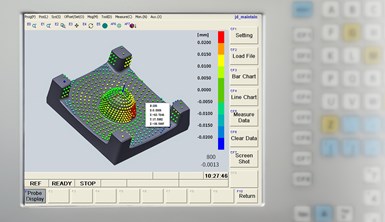
The control creates an accuracy heat map showing if a part is in spec and can be exported with the machining data.
Mold Machining Advantages
High-precision machining centers with on-machine measurement and intelligent modification technology can achieve stable machining of micron-level molds by accurately judging, compensating and correcting inherent deviations such as tool errors and material deformation. It can also achieve long-term continuous processing of PCD cutting tools and produce surface finishes down to the nanometer level.
This technology turns traditional machining into digital control that reduces quality problems caused by inexperienced operators, saves time when measuring parts on the machine and reduces the impact of external inherent deviations on production, improving a shop’s overall machine tool utilization rate.
Acknowledgment: Thank you to Jingdiao’s Jason Wong for his contribution to this article.
Related Content
The Benefits of Hand Scraping
Accuracy and flatness are two benefits of hand scraping that help improve machine loop stiffness, workpiece surface finish and component geometry.
Read MoreHands-on Workshop Teaches Mold Maintenance Process
Intensive workshop teaches the process of mold maintenance to help put an end to the firefighting culture of many toolrooms.
Read MoreHow to Eliminate Chatter
Here are techniques commonly used to combat chatter and guidelines to establish a foundation for optimizing the moldmaking process.
Read More6 Ways to Optimize High-Feed Milling
High-feed milling can significantly outweigh potential reliability challenges. Consider these six strategies in order to make high-feed milling successful for your business.
Read MoreRead Next
Defining What Makes High-Speed Machining Different
A look at what true high speed and true high precision can produce, as well as what makes high-speed machining different from traditional milling.
Read MoreOn-Machine In-Process Inspection Improves Machining Accuracy
High-speed machining with on-machine in-process inspection, machining management, and control technology reduces machining time and eliminates manual bench work.
Read MoreHow to Use Strategic Planning Tools, Data to Manage the Human Side of Business
Q&A with Marion Wells, MMT EAB member and founder of Human Asset Management.
Read More

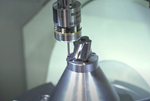





.jpg;maxWidth=300;quality=90)






_300x250 1.png;maxWidth=300;quality=90)







.png;maxWidth=300;quality=90)







